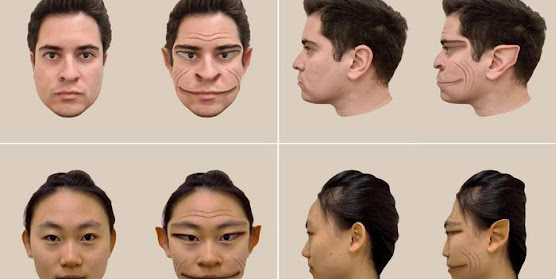A Rare and Nightmarish Phenomenon Morphs Other People’s Faces into Demons
- A rare visual disorder, known as prosopometamorphopsia (PMO), distorts people's faces so severely that they're no longer recognizable.
- A new study analyzes one specific case of PMO where a patient was able to see faces normally on digital screens and paper but were a distorted mess when seen in person.
- This case allowed researchers to accurately image the lived distortions of the patient, giving an unprecedented glimpse into what some of these patients are actually seeing.
Imagine waking up one day, and every face you see has somehow turned demonic, distorted, or otherwise unfamiliar—a world full of unrecognizable strangers. That’s the everyday reality of many people living with prosopometamorphopsia, an expert-level spelling bee question and rare visual disorder that can distort a face’s shape, texture, color, or even its entire position.
Although the number of cases of prosopometamorphopsia, or PMO, only edges above 100 or so, the various ways in which PMO presents are incredibly varied. For some people, facial features appear to move on their own, while for others they can droop or twist. According to Scientific American, patients reported skin that looked more like tree bark, transformed into geometric shapes, or superimposed faces on other people.
The late Oliver Sacks co-authored a paper about PMO back in 2014, and now Brad Duchaine, a professor of psychological and brain sciences at Dartmouth, is carrying on that legacy of scholarship. In 2021, Duchaine’s lab transitioned from studying face blindness—a condition where someone struggles to recognize people’s faces (or even themselves)—to studying the more niche condition of PMO. The team launched a website dedicated to the condition, and some 60 people reached out with described symptoms.
However, one specific case presented an unprecedented opportunity. While most PMO cases report visual distortions in all contexts, a 58-year-old man described symptoms where he could see faces normally on digital screens and paper, but those same people became ‘demonic’ once viewed in person. This gave Duchaine, along with PhD student Antônio Mello, the unique ability to actually image the faces this PMO patient was seeing. The results of this study were published today in the journal The Lancet.
“In other studies of the condition, patients with PMO are unable to assess how accurately a visualization of their distortions represents what they see because the visualization itself also depicts a face, so the patients will perceive distortions on it too,” Mello, lead author of the study, said in a press statement. “Through the process, we were able to visualize the patient’s real-time perception of the face distortions.”
To get into the mind—and behind the eyes—of someone with PMO, the researchers took photographs of people and displayed the photos on a digital screen while the patient simultaneously looked at the person in real life. The researchers received real-time feedback and manipulated the photograph until the digital version matched the patient’s lived experience. The results were indeed ‘demonic,’ as if the face’s skin was being pulled back from the crown of the head.
So what exactly causes this distortion? Well, previous literature points to brain lesions on the visual regions of the brain. In a study from April of 2023, Duchaine discovered that 44 out of 48 brain scans of patients with PMO showed these lesions, which points to brain damage as the likely cause. However, most patients who have reached Duchaine through his website tell a different story.
“If you look in the literature, it’s almost entirely people who suffered brain damage,” Duchaine told Scientific American in December 2023. “But I think that might be because that’s who’s showing up in neurological clinics, whereas we’re hearing from people through the internet, and very few of them are aware of any brain damage that coincided with the onset of their distortions.”
Duchaine and Mello hope that their research will help patients avoid misdiagnosis due to the rarity of the condition, and also help promote public awareness of this socially debilitating disorder.
“It’s not uncommon for people who have PMO to not tell others about their problem with face perception because they fear others will think the distortions are a sign of a psychiatric disorder,” Duchaine says in a press statement. “It’s a problem that people often don’t understand.”
A Rare and Nightmarish Phenomenon Morphs Other People’s Faces Into Demons (msn.com)



Comments
Post a Comment